Although most pre-university programmes are recognised globally by universities, it is vital to spend time finding out more about each of the programme for a better transition to your bachelor degree and further. There are many choices of pre-university programmes and we understand that it can be challenging to choose one that suits you best. A sequel to our article “Pre-University 101: Everything You Need to Know” an overview in deciding a pre-university programme, we will explore international pre-university courses in more depth in this article.
If you want to know more about local programmes offered in our home country, do click here.
Comparison between Pre-University Programmes
As discussed in the previous article, the few criteria that you can use in comparing the programmes are course duration, timing of intake, subject choices, assesment method, tuition fees and more. We will summarise the differences between various pre-university programmes in the table below for your easy understanding and comparison.
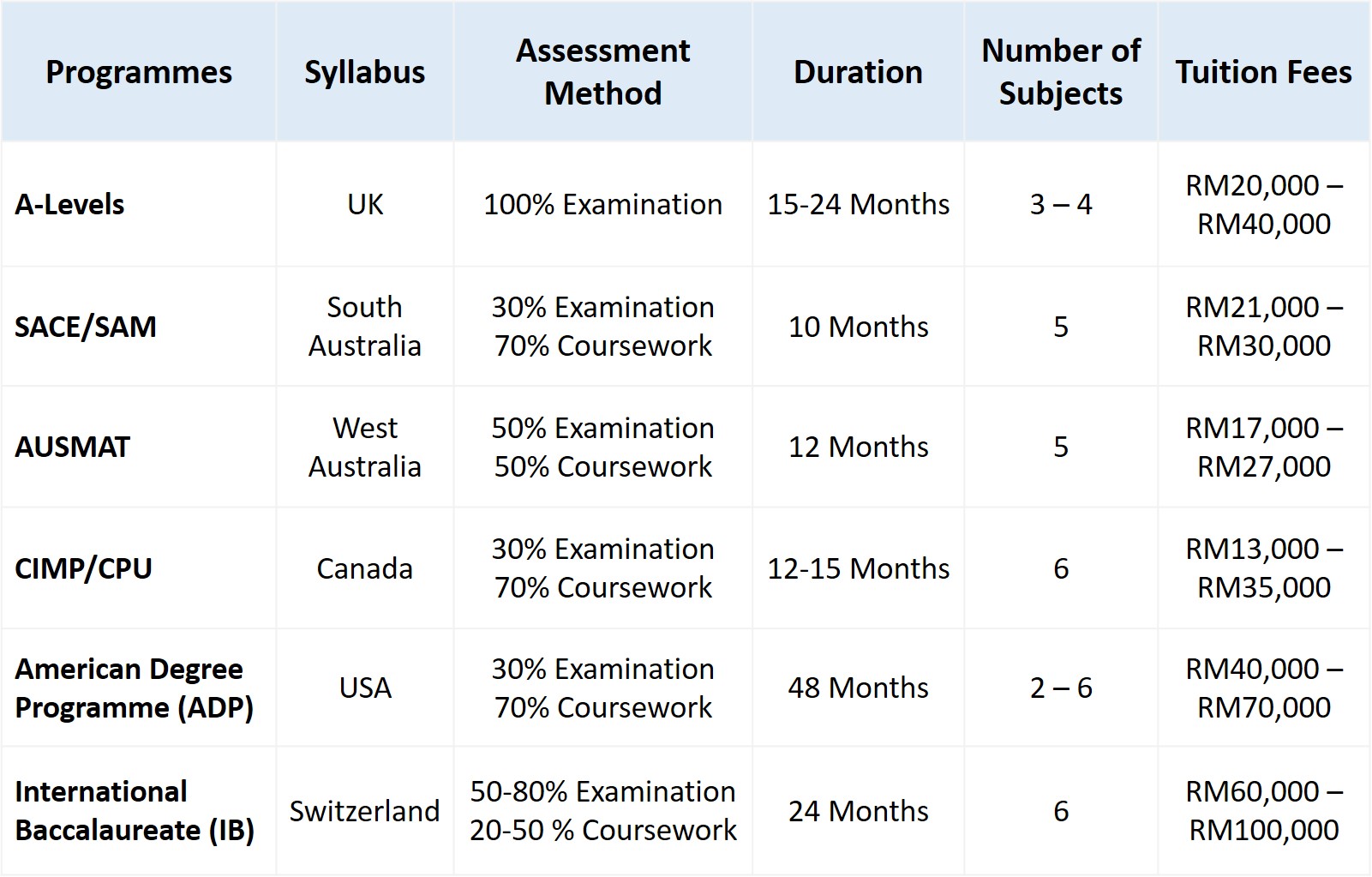
1) A-Levels
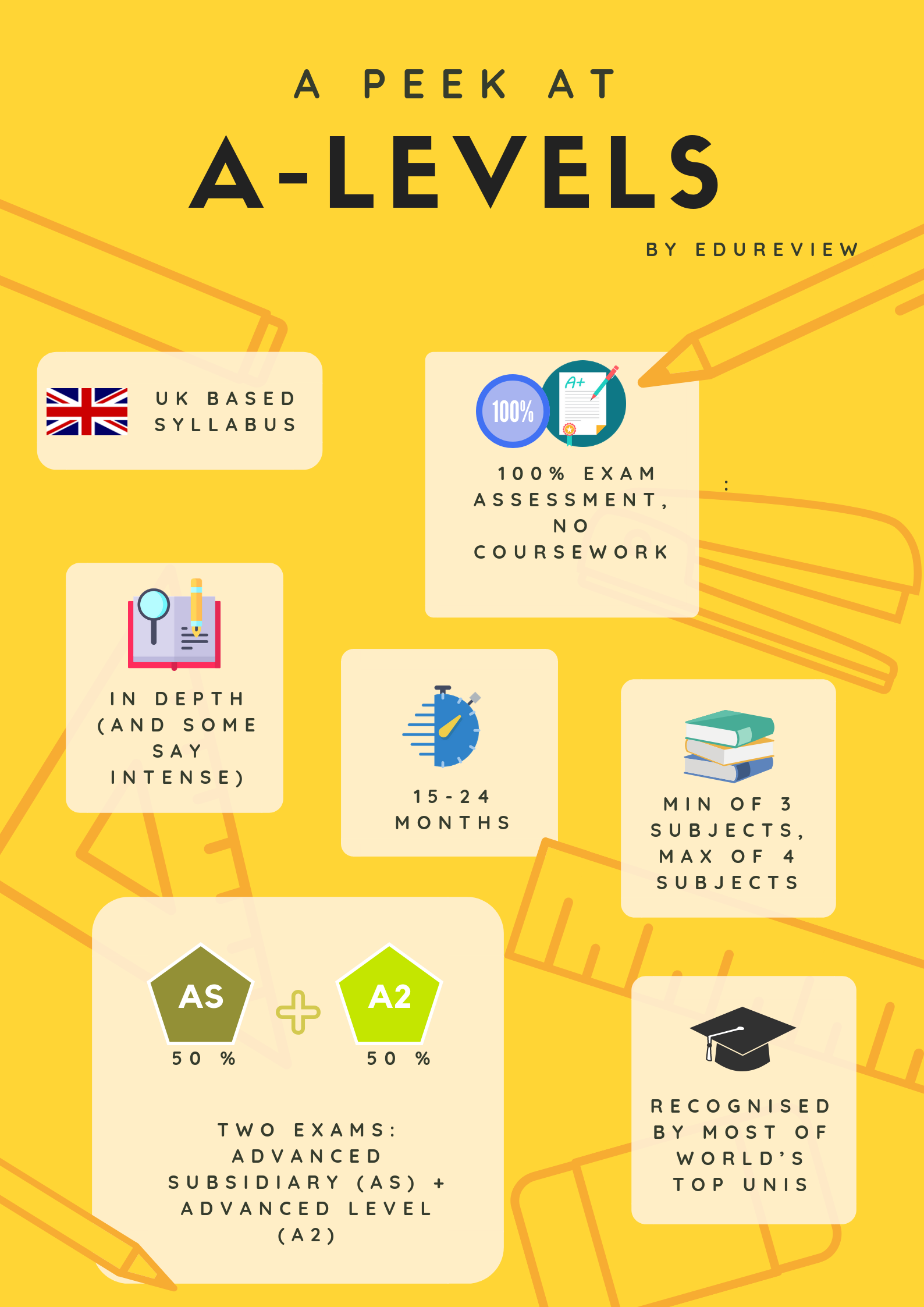
Overview
A-Levels (or also known as Advanced Level) is a UK-based pre-university programme and is recognised by most of the world’s top universities. This programme is most popular among students who aspire to pursue their studies abroad. In Malaysia, the examination is administered Cambridge International Examinations (CIE) and Edexcel, with CIE being the more popular option.
A Level is a 100% exam-based course where students can take a minimum of 3 subjects and a maximum of 4 subjects. While 3 subjects may sound easy compared to SPM or IGCSE, take note that the learning materials can be quite intense as they are more in-depth than most pre-U programmes. In essence, to excel in the papers, students really need to understand what they are studying because often, they require a lot of analysing.
Assessment method/grading system
The examination is divided into two parts: Advanced Subsidiary (AS) and Advanced Level (A2). AS papers typically cover the foundation of the subjects while A2 papers touch on more complex topics.
Each exam will contribute to 50% of the students’ total score.
Summary
| Pros | Cons |
|
|
Is it right for you?
If you’re sure that you want to pursue your degree abroad, or looking for a globally recognised pre-university qualification, or you prefer an academically-inclined and exam-oriented assessment rather than coursework, then A-Levels it the right choice for you!
2) SACE Internationals / SAM
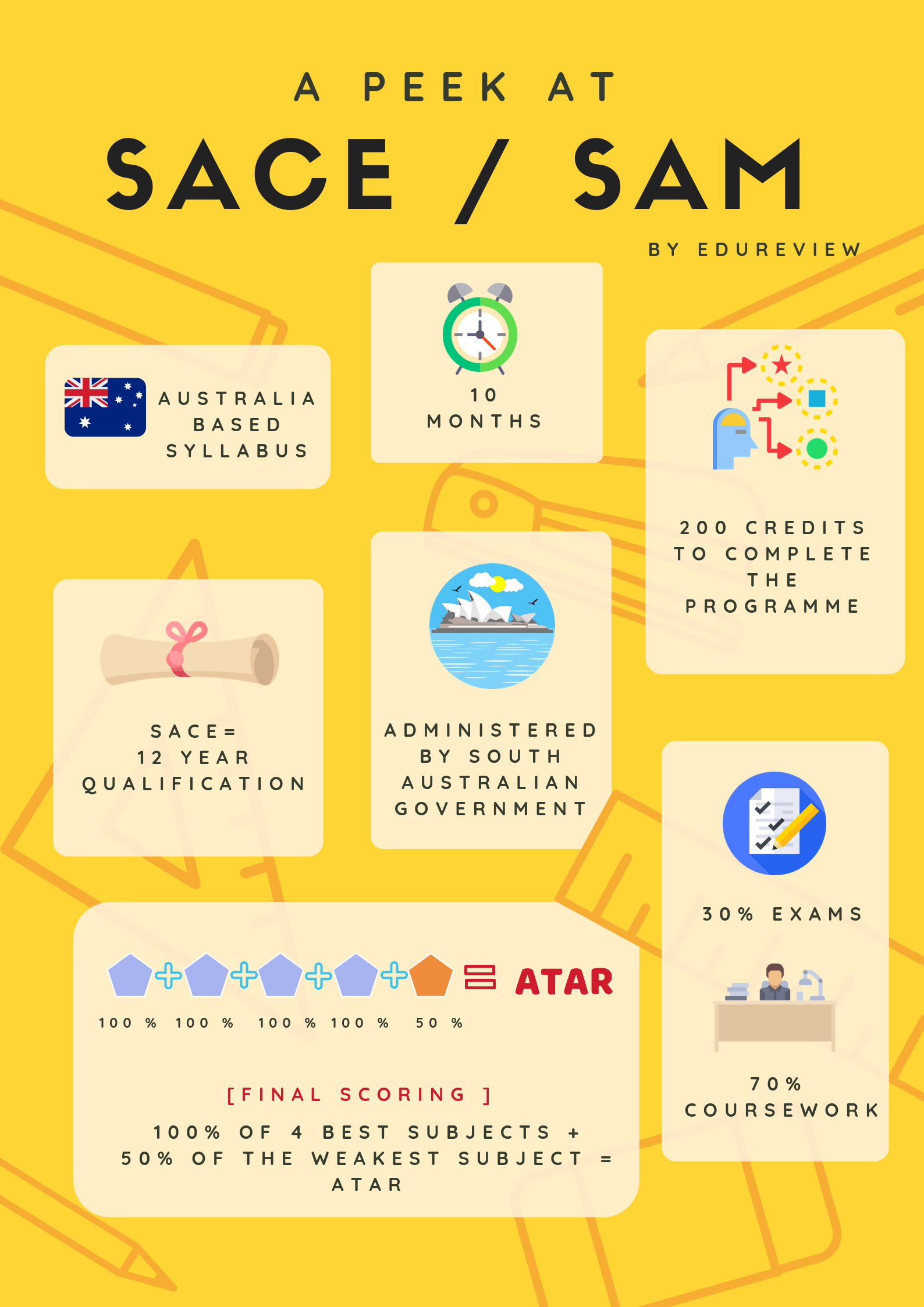
Overview
SACE Internationals (formerly known by South Australian Matriculation or SAM) is administered by the Board of South Australian and it is basically a two-stage certificate. At the end of this programme, you will be awarded a certificate that is equal to the Australian Year 12 qualification. Students need to select 5 subjects and each subject may either worth 10 or 20 credits. Typically, the subject will be worth 10 credits if it is only for one semester and 20 credits for the whole year. You can choose whichever subject you prefer (or recommended by your institutions), but there are also some compulsory subjects (e.g. English Studies) that you will also need to take. Ultimately, to graduate with a SACE certificate, you will need a total of 200 credits at the end of the programme.
Assessment method/grading system
70% of the programme consists of coursework / class assessment while the remaining 30% are examinations. You will be graded through a scoring called the Australian Tertiary Admission Rank (ATAR) where in the end, you will get a single overall score. The score is derived in quite an interesting method.
|
100% of your four best subjects + 50% of the weakest subject = ATAR. |
The maximum score you can get is 99.95.
Summary
| Pros | Cons |
|
|
Is it right for you?
If you prefer continuous assessments and coursework throughout the course, then SACE/SAM is the right choice for you. This programme is globally recognised and has shorter duration which makes this one of the most popular choice for students.
3) Australian Matriculation (AUSMAT)
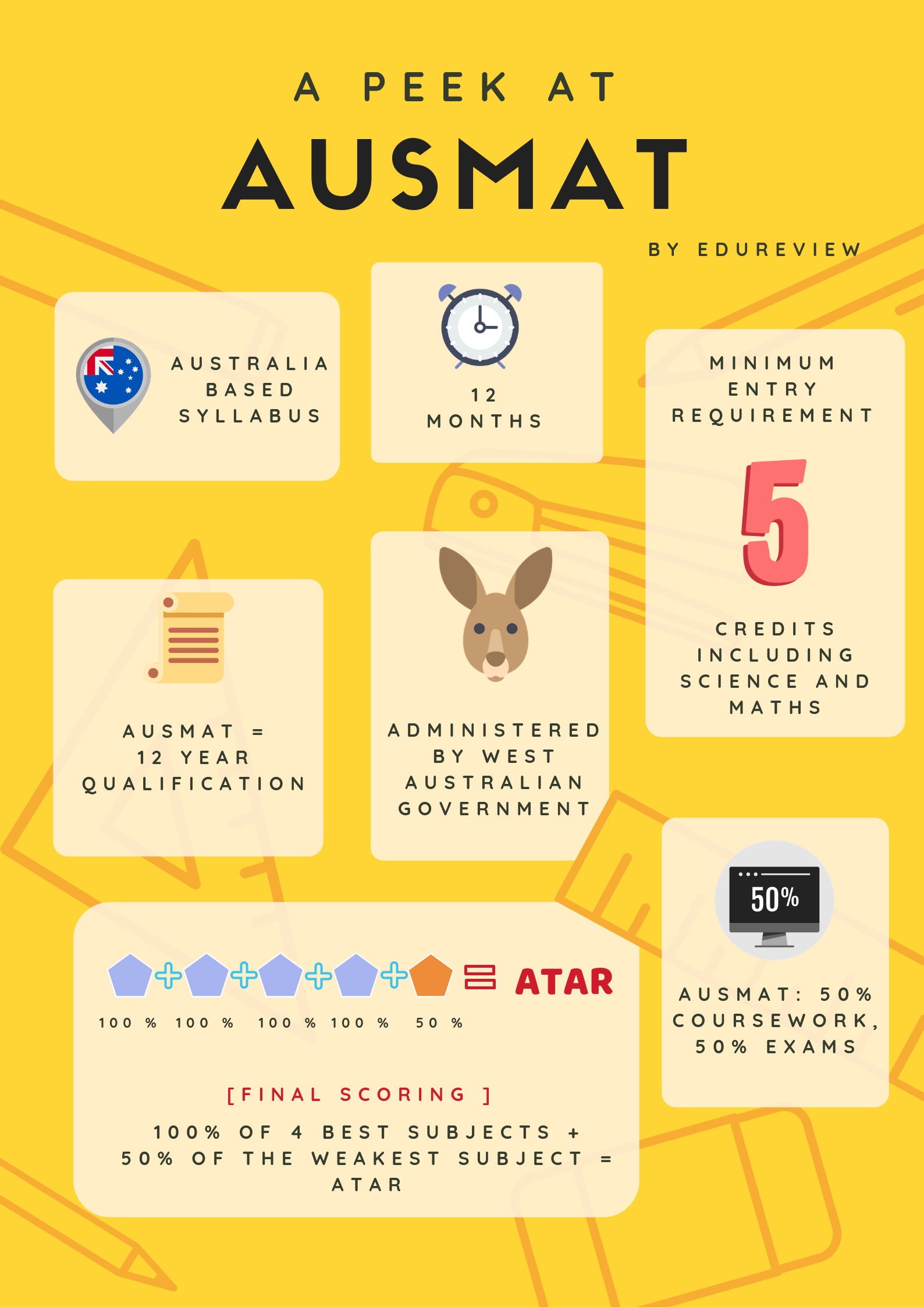
Overview
Australian Matriculation (AUSMAT) is administered by the Western Australian government. AUSMAT is similar to SACE in many ways, as such, you are required to take five subjects, it is based on continual assessment (so you don’t have to worry too much about a single exam determining your two years worth of effort). You are required to have a minimum of 5 credits in SPM or O Levels and your final result will be based on the ATAR system.
So, obviously you will have no problem gaining entry to Australian universities of your choice. Nevertheless, SAM / AUSMAT are internationally recognised in other countries as well. One difference between the Southern and Western Education Certificate of Education is that those who take AUSMAT will also need to undergo the Online Literacy and Numeracy Assessment (OLNA). Only when a student passes the minimum numeracy and literacy standard will they be granted with the AUSMAT certification.
Moreover, the choices of AUSMAT subjects in Malaysia are pretty restricted. Apart from English, a compulsory subject, usually students can only choose these subjects:
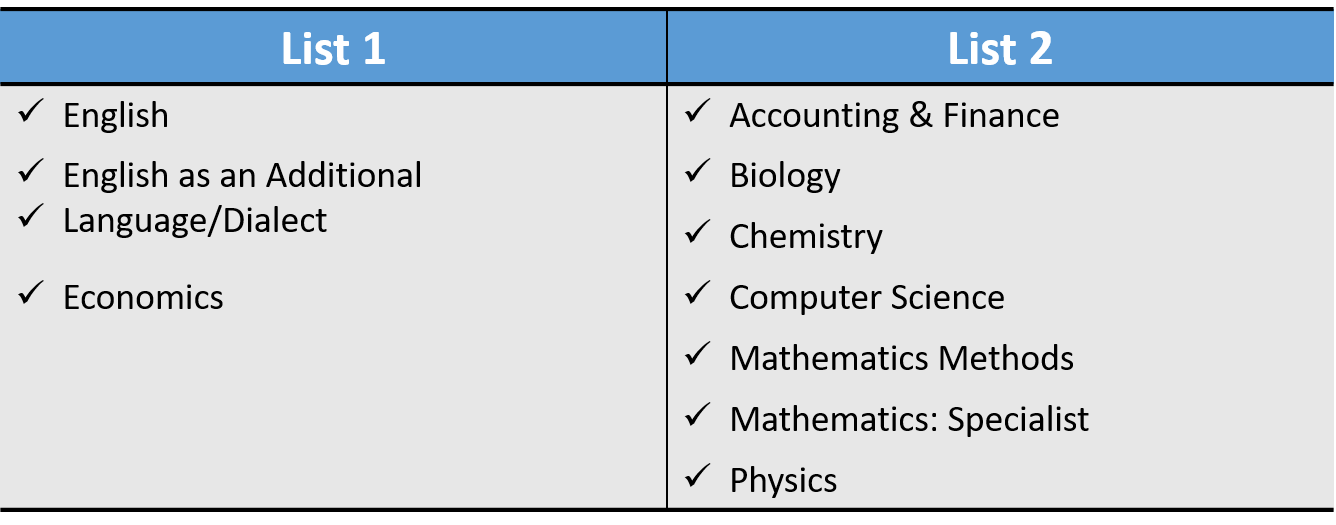 (This list may expand depending on the institutions)
(This list may expand depending on the institutions)
Assessment method/grading system
50% of the programme consists of coursework / class assessment and 50% are examinations. You will be graded through a scoring called the Australian Tertiary Admission Rank (ATAR) where in the end, you will get a single overall score. The score is derived in quite an interesting method.
|
100% of your four best subjects + 50% of the weakest subject = ATAR. |
The maximum score you can get is 99.95.
Summary
| Pros | Cons |
|
|
Is it right for you?
If you prefer a good balance between coursework and final examination, or you are an indecisive person who prefers to follow a list of structured subjects, then AUSMAT is the right choice for you. Similar to SACE/SAM, this programme is globally recognised and has shorter duration
4) Canadian Pre-U (CPU and CIMP)

Overview
There are two primary programmes offered – Canadian Pre-University (CPU) and Canadian International Matriculation Programme (CIMP), and they both lead to an Ontario Secondary School Diploma (Canadian Year 12 qualification).
The courses are conducted on a modular basis so you will need to take 2-3 subjects per semester. There are 6 subjects that you need to take in total, with English being a compulsory subject. But in some institutions, there are more than twenty subjectes for you to choose from. That is far more options than other pre-U programmes.
Furthermore, Canadian Pre-U is also known to be an all-rounded programme. The assessments are a mixture of essays, tests, presentations, group work, and lab reports for those who are taking science subjects. Rather than just merely delving into books, you will have the chance to get interactive and polish up your other soft skills.
Assessment method/grading system
You will be graded using the Ontario Rubric which focuses on four main aspects – knowledge and understanding, thinking and enquiry, communication, and application.
For each subject, the grade breakdown will be 70% from continuous assessment/coursework and 30% from the final exam. Then, your final result will be an average of all 6 subjects taken. Lastly, you will also need to complete the Ontario School Secondary Literacy Test (OSSLT) and several hours of community service.
Summary
| Pros | Cons |
|
|
Is it right for you?
If you are a big fan of Justin Trudeau and its people, you are not fond of letting just examination determine your future, and you are looking for a course that is more holistic and hands-on learning, then CPU and CIMP are the right programmes for you!
5) American Degree Program (ADP)
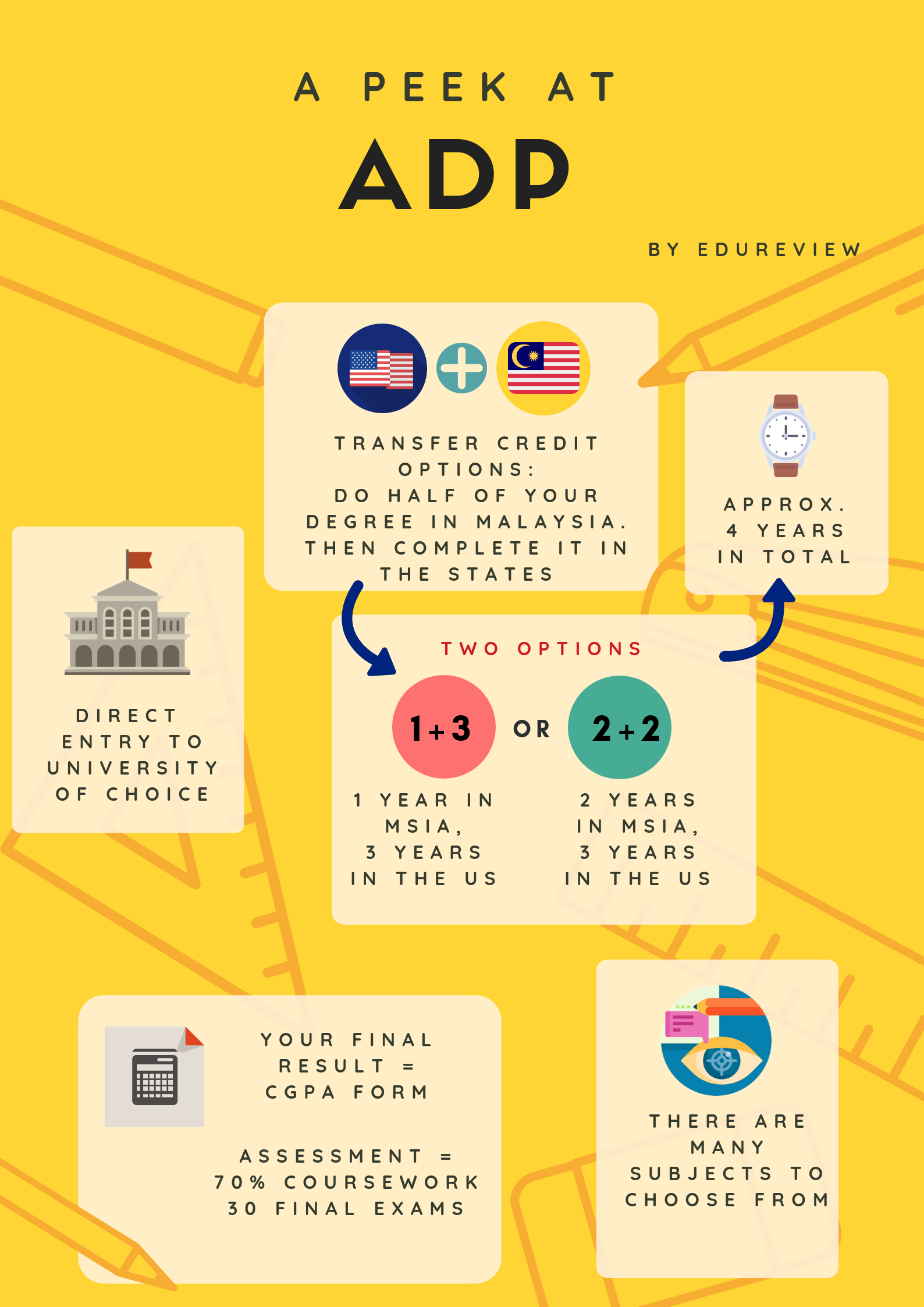
Overview
Although it falls under the category of Pre-U, American Degree Program (ADP) is a bit different from other courses because its enrolment means that you are already doing your degree. How so? Well, when doing an ADP programme, typically you will be given a transfer credit option – meaning that you will be doing half of your degree in Malaysia first (i.e. one to three years), then you can get transferred to a university in the United States (US) to complete your degree.
Usually, there will be three to four subjects to be taken for a semester and the selections of subjects are typically pretty broad – you will be spoilt for choice. Nevertheless, you will be expected to take at least half of the subjects that are relevant to your course.
Assessment method/grading system
You will most likely to be assessed through coursework (70%) and final exams (30%), but this may vary according to the university that you enrolled to.
Your result will be results will be a single numerical score, called the Cumulative Grade Point Average (CGPA). Each letter grade you receive (A to E) corresponds to a grade point. Your CGPA is the average of all your grade points, usually weighted by the number of credits given for each course. The maximum score is 4.0
Summary
| Pros | Cons |
|
|
Is it right for you?
If you have already decided to pursue a degree or you are set to study abroad (specifically in the US), ADP is definitely the right choice for you. By joining this programme, you are technically already doing both pre-u and degree. If you choose to withdraw halfway, you will lose both the certification.
6) International Baccalaureate (IB)
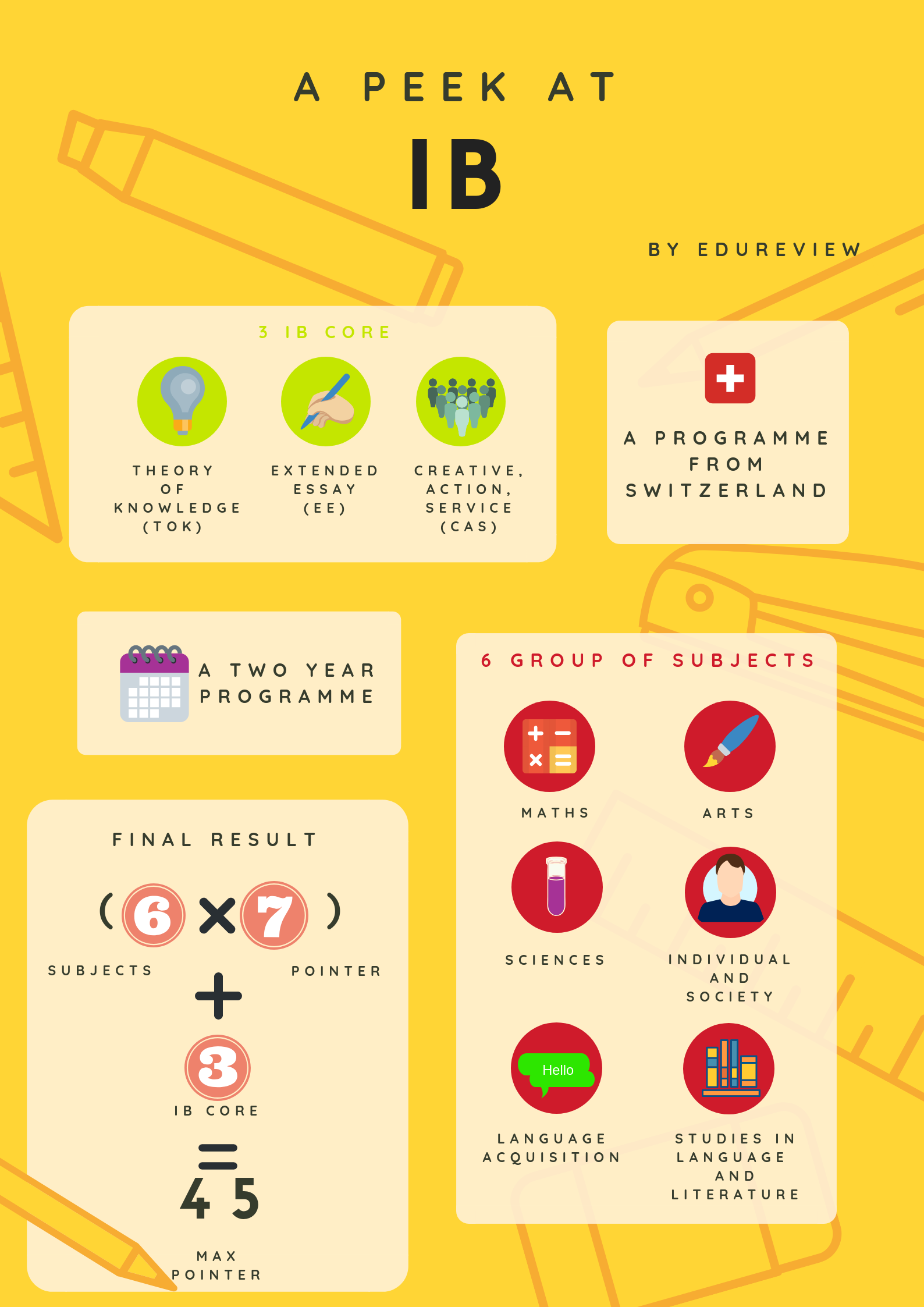
Overview
International Baccalaureate Diploma Programme (IBDP) or more popular as IB, is an A-Level rival programme from Geneva, Switzerland. In Malaysia, currently, there are 21 institutions offering the IB Diploma Programme. It takes two years to complete the course, and students are required to take six subjects across various disciplines. These include :
- Group 1: Language and Literature (e.g. English)Group 2: Language Acquisition (e.g. Spanish, German, French)
- Group 3: Individuals and Societies (e.g. Economics, Geography, History)
- Group 4: Sciences (e.g. Biology, Chemistry, Physics)
- Group 5: Mathematics (e.g. Mathematics, Mathematics Studies)
- Group 6: The Arts (e.g. Music, Theatre Arts, Visual Arts)
For each subject, you can choose whether to take them at a Higher Level (HL) or Standard Level. Just as the name suggests, HL subjects are generally more in-depth than SL subjects. And in total, you are required to take three HL subjects and 3 SL subjects.
What makes IBDP more challenging is that, in addition to the six subjects, you will also need to complete another three core components of the IB programme :
Theory of Knowledge (TOK) – 1,200 – 1,600 words essay and presentation on critical subjects
Extended Essay (EE) – a 4,000-word research paper on a subject of your choice
Creativity, Action, Service (CAS) – 150 hours of community service, participation in creative activity (e.g. art exhibition to raise money for charity) and athletic or sports programme (e.g. yoga, badminton).
Assessment method/grading system
Internal assessment (20% to 50%) + final exams + the three IBDP core components = IB Diploma
The internal assessment which includes oral presentations, practical work, written papers will be marked by your own teachers/lecturers. Nonetheless, the external assessment like the exam papers will be marked by external IB examiners
Each grade is assigned with a point with 7 being the highest (sort of like achieving A+) and 1 being the lowest. Hence, if you obtain the highest score for all 6 subjects, your score will be 6 subjects x 7 points per subject = 42 points.
This maximum score that’s achievable is 45 points (i.e. 42 points for 6 subjects + 3 points for Core Components). To be awarded an IB Diploma, you will need to gain at least 24 / 45 points.
Summary
| Pros | Cons |
|
|
Is it right for you?
Similar to A-Levels, IB is suitable for you if you’re sure that you want to pursue your degree abroad, or looking for a globally recognised pre-university qualification. However, as A-Levels is more academically-inclined, IBDP will be a better choice if you prefer a more holistic, interactive and flexible learning.
If you are still unsure at the end of the day, then choose a programme that gives you flexibility and versatility to choose your degree later on. Whichever you choose, just remember to take a deep breath and consider all options based on our checklist given from our previous article “Pre-University 101: Everything You Need to Know” before deciding!
To learn more about local or home-grown pre-university programmes , you can read them here.








